Ajax versus PSV, the De Topper, have had a long-standing rivalry in the Netherlands.
Before this weekend, Ajax had won 22 head-to-head matches while PSV Eindhoven had won 21, with 12 ending in draws.
Both clubs averaged 3.15 goals per match.
PSV has won three of their past five encounters, while Ajax has won two.
This fixture has always made for an exciting quest, making it the biggest game in Eredivisie.
In this tactical analysis, we dive into the tactics of both teams and see how PSV outsmarted Ajax.
We’ll also cover a little about the coaches who went head-to-head in this fixture, which could tie up the whole picture.
Lineups
Both coaches could not afford to choose the starting eleven carelessly.
Pasveer (GK), who has had a promising start to his ageing career, was placed between the sticks in Alfred Schreuder‘s hybrid 4-1-4-1 formation.
With Sánchez (RB) and Rensch (LB) manning the full-back positions with Wijndal injured, Timber (RCB) and Bassey (LCB) form the central defence.
The midfield was made up of five players: Álvarez (CDM), the reliable one in the middle, Berghuis (LCM), Kudus (RCM), Tadić (LW) captaining the team, and Bergwijn (RW) on the flanks.
After proving his value as a team regular regularly, Brobbey (CF) was awarded the starting position.
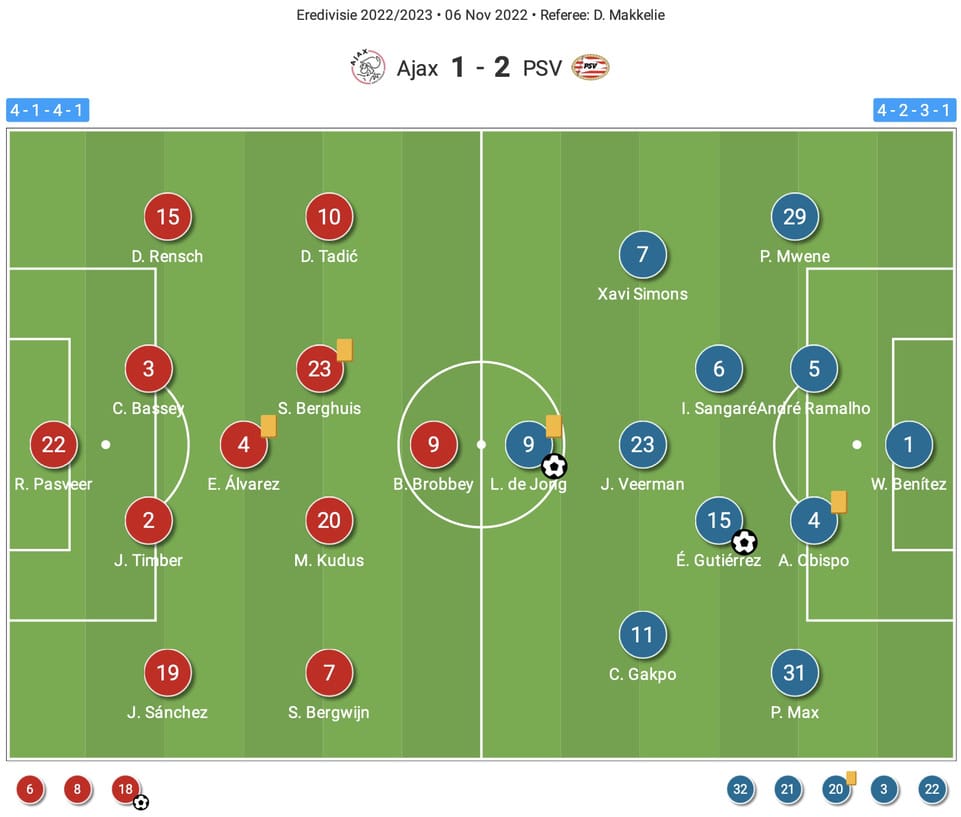
Ruud Van Nistelrooy used his preferred 4-2-3-1 system with a few minor adjustments from the previous game.
Benitez (GK) started between the posts, along with Mwene (RB) and Max (LB) as fullbacks and Ramalho (RCB) and Obispo (LCB) as the central defenders.
Sangaré (RDM) and Gutiérrez (LDM) served as the double pivot in the midfield, with Veerman (CAM) as the centre attacking midfielder and Xavi Simons (RW) and Cody Gakpo (LW) as the wingers.
In this game, Luuk De Jong (ST) was chosen as the striker as well as the captain despite Gakpo’s start.
Background of coaches
A little introduction to the respective coaches that faced off reveals their underlying facts.
Alfred Schreuder went on to manage Hoffenheim after assisting ten Hag at Ajax for a season.
He set his stance in the club where he got a chance to assist Ronald Koeman for Barcelona.
In January 2022, Schreuder was hired as head coach of Club Brugge after his dismissal from Barcelona.
His time with the Belgian club saw him achieve the greatest victory percentage of his career, 71.5%, followed by winning the league.
Since Alfred Schreuder took charge of the club in January,
it has won more points (32), scored more goals (31), attempted more shots (201),and had more possession (61%) than any other team in the Jupiler Pro League.
He was given a two-year contract by Ajax for the 2022–23 season, starting in May.
His best quality—and ten Hag’s, too—is his tactical acumen.
Ajax employs his counter-press, build-up from the back play, and usage of clever manoeuvres.
Starting his tenure at Ajax, he has
won 11 of the 18 games played, lost just six, and drawnonly one, with a goal difference of 21.
Although this seems to be a positive start after ten Hag’s departure, they have not been successful in the Champions League.
PSV veteran Ruud van Nistelrooy has led PSV’s junior teams to success in the past and is off to a great start in his senior squad career.
Under the management, PSV has won 15 of
its last 23 games, with a 65% winning rate and a 35-goaldifference.
His employment provided PSV with the solution they were looking for.
An intriguing detail about this match is that both coaches were hired in the same month of the year to take up coaching positions in the most elite clubs in the Netherlands.
This is only the second meeting between the coaches.
The only match between the two saw PSV take an edge over Ajax, beating them 5-3 in an away game in Johan Cruyff Shield.
In contrast to Roger Schmidt, the previous PSV coach used a 4-2-2-2 style, which resulted in absolute mayhem whilst attempting to regain control.
Schmidt was a trainer who attempted to play under tremendous stress and pressure, but it didn’t turn out well.
Van Nistelrooy wants to focus on having control of the ball.
It is critical to maintain possession and ensure that you always have an overload against a rushing opponent.
Van Nistelrooy is concerned that his squad is offensive and dominating on the ball.
PSV would consider reaching the Champions League group stage for the first time in four years a huge accomplishment.
In recent years, Ajax has been playing Champions League football, and with their relative success, they have made a lot of money not just from being in the league but also by selling Frenkie de Jong, Matthijs de Ligt, and Lisandro Martinez.
PSV’s stars, such as Gakpo and Sangare, will have a far greater chance of remaining, and van Nistelrooy will have a much better chance of becoming a successful coach as a result.
Limiting the role of centre-backs
Ajax was unable to build from the back as they expected.
Under Ruud van Nistelrooy’s style of play, PSV applied steady pressure and formed a very excellent team structure to negate the centre-backs’ passes to the front.
In previous games, Schreuder has shown that his centre-backs are crucial to playmaking until the last third of the field.
Timber and Bassey have been Ajax’s defensive tandem.
They expertly support and dribble past players, gaining momentum to push the team forward.
The coach recognises this potential, as seen by the photos below from the UEFA Champions League game versus Rangers.
Either of them would move up the pitch to support within the block, rather than going wide to the outside space, to breach the opponent’s team structure.
This provided them with the freedom they needed to go up the field, opening several possibilities.
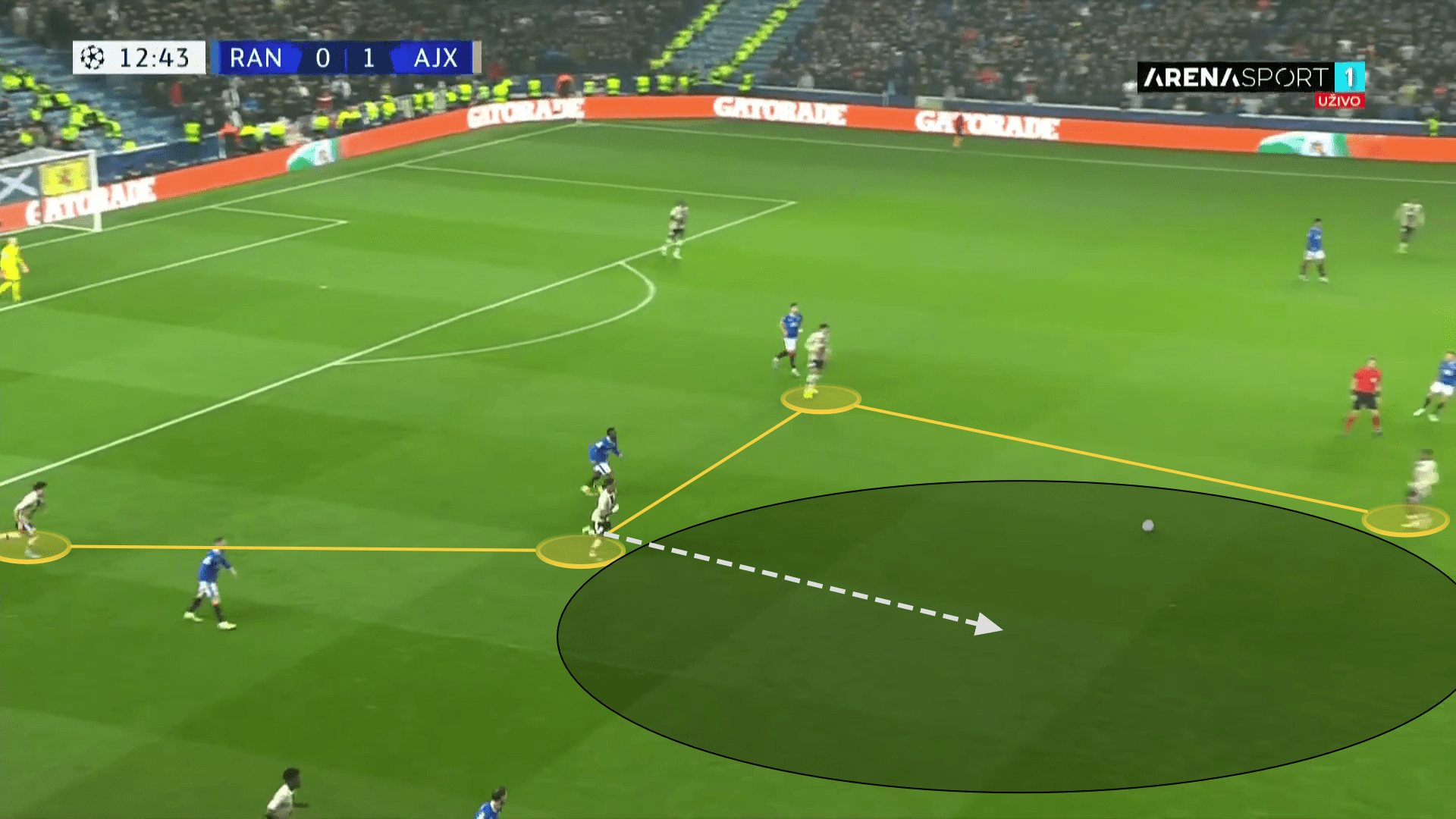
While Bassey remains low, Timber sprints to the front to provide the attackers half-space.
Both defenders have formed a strong relationship and take turns going up the pitch.
When the keeper gets the ball while facing pressure, Timber boldly places himself between the opponents, breaking the typical support from the centre-backs.
Timber does a quick scan to plan his following action before receiving the pass.
Álvarez will now position himself next to Timber to make rapid passes up the field.
This allows the team to increase manpower in the midfield.
The statement is bold by Schreuder, making his centre-backs pivotal when it comes to playmaking from the back.
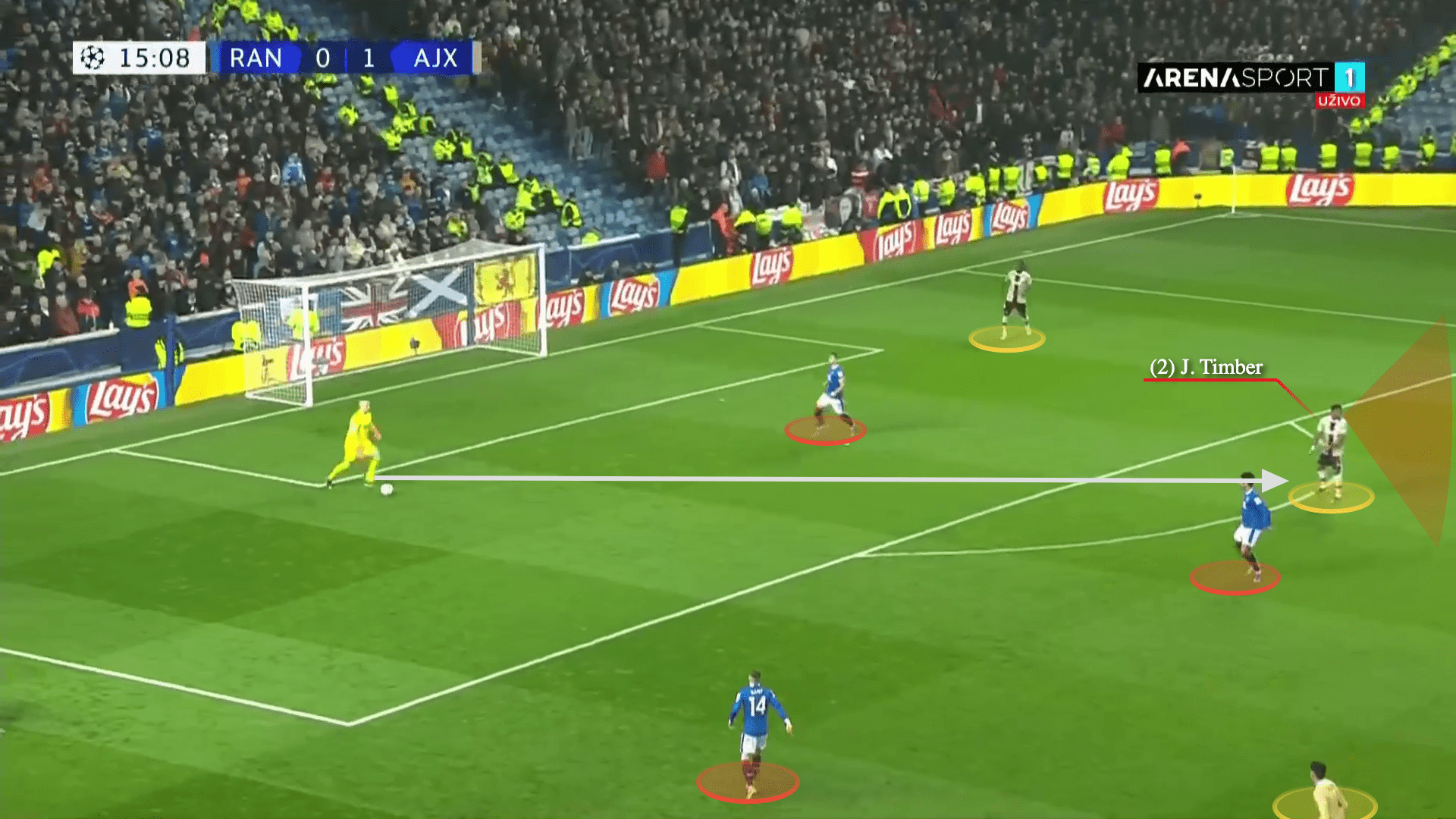
Bassey also tends to execute dribbles in the opponent’s half.
Here’s an example of him taking the ball away from Mo Salah in Liverpool’s half and utilising his strength to wriggle through to the open space.
This does create possibilities for other players to position themselves in a better position while moving up the pitch.
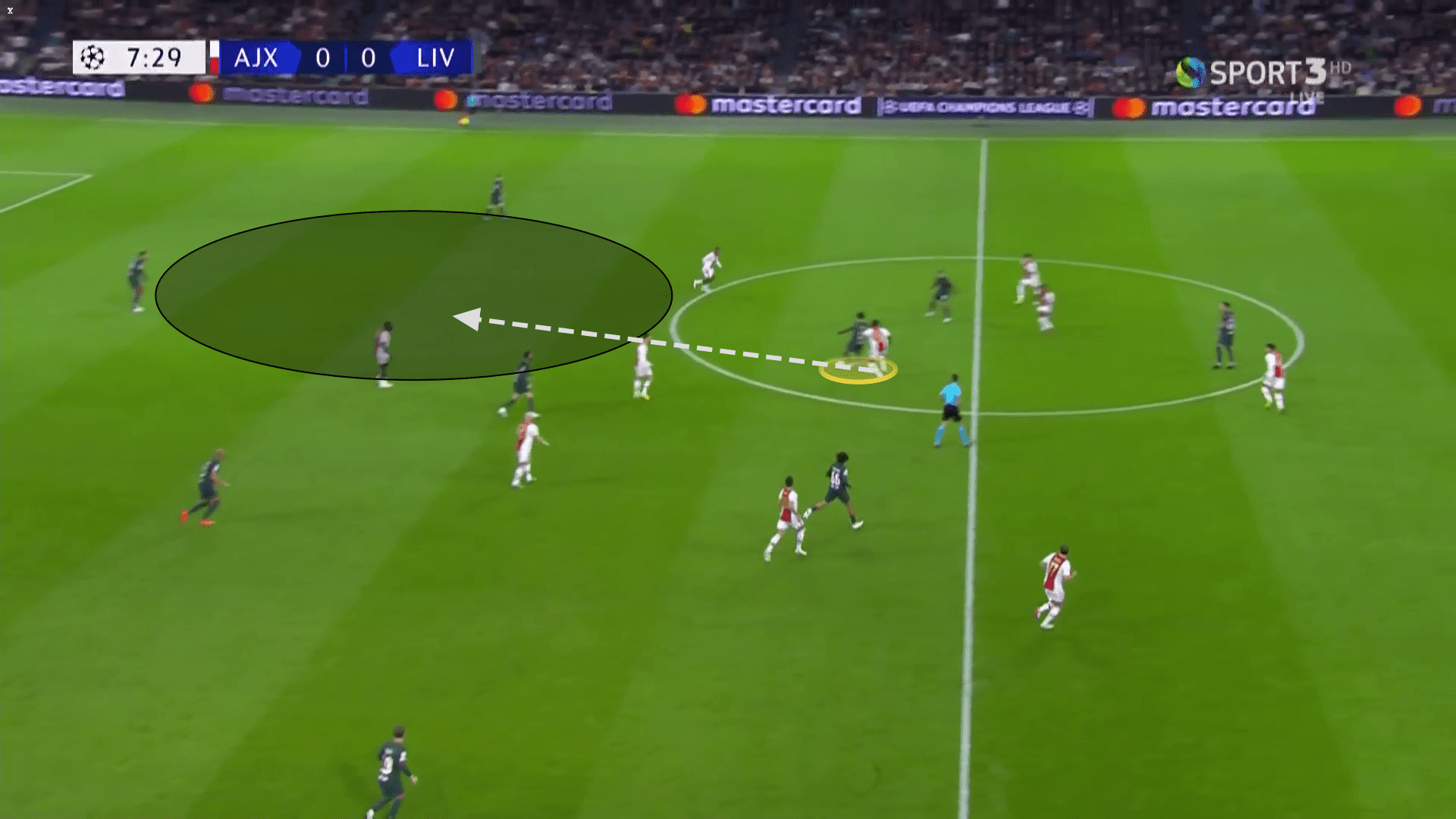
PSV accepted the challenge of suppressing them in the opponent’s half while remaining focused on marking the right players and forming the ideal team structure to collapse Ajax’s playmaking from the back.
Veerman often went up front to pair up with de Jong to press whilst Sangaré took the left place and possessed the aggressive mindset needed in this situation.
Gutiérrez stays as the only midfielder below Sangaré, turning to a 4-1-3-2 formation.
This did not allow Timber and Bassey to place themselves in their comfort zone.
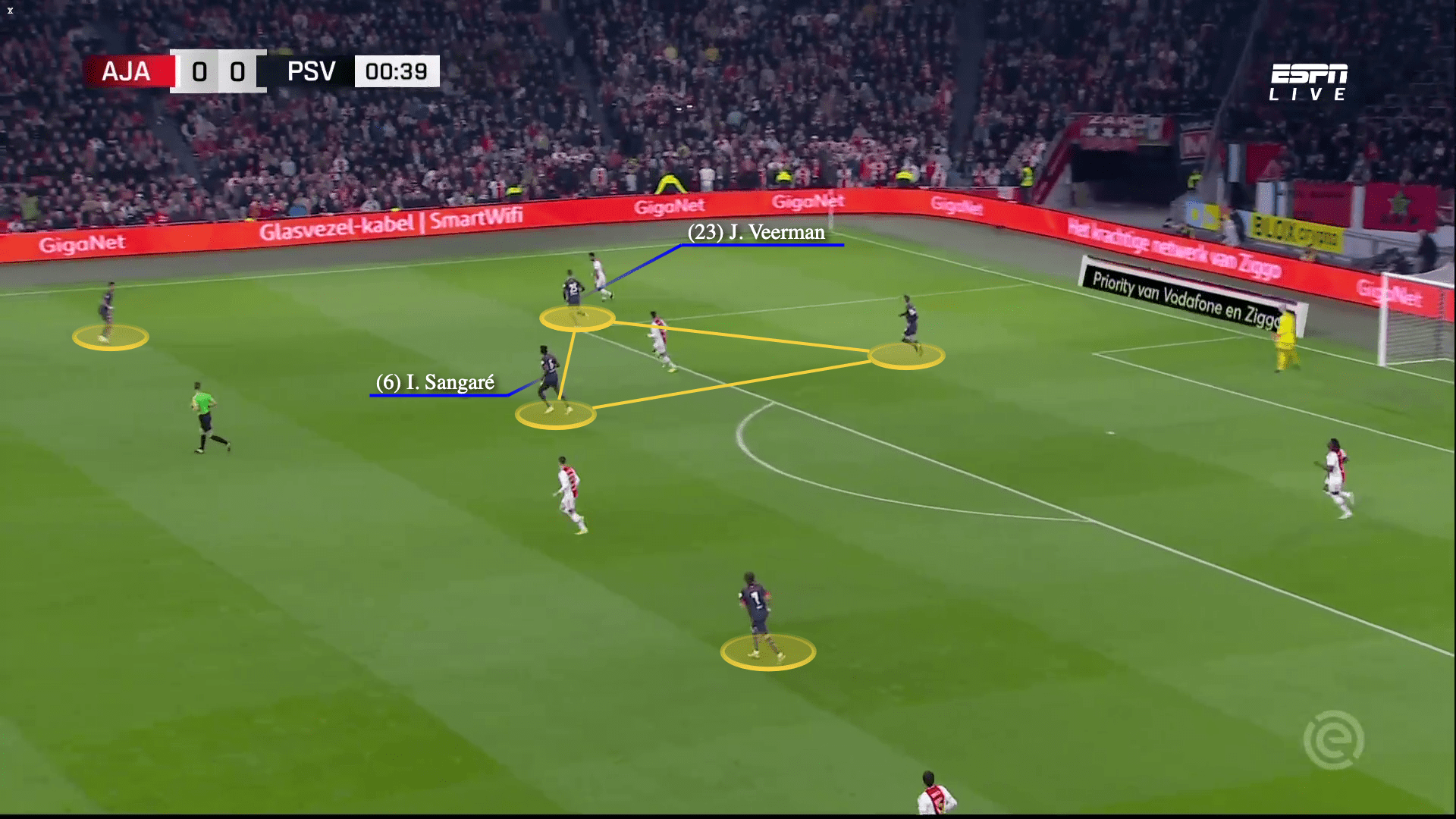
Veerman, whose quickness de Jong lacks, was the ideal candidate to press the goalkeeper or the centre-backs.
While Gakpo carefully marks Timber, who has positioned himself where he may cause trouble, Veerman sprints to push the goalkeeper.
The crucial function of the centre-backs in Ajax’s playmaking from the back is eliminated by this structure.
Now that Veerman goes above de Jong, the striker acts as a cover for the press, being aware of players who are left unmarked.
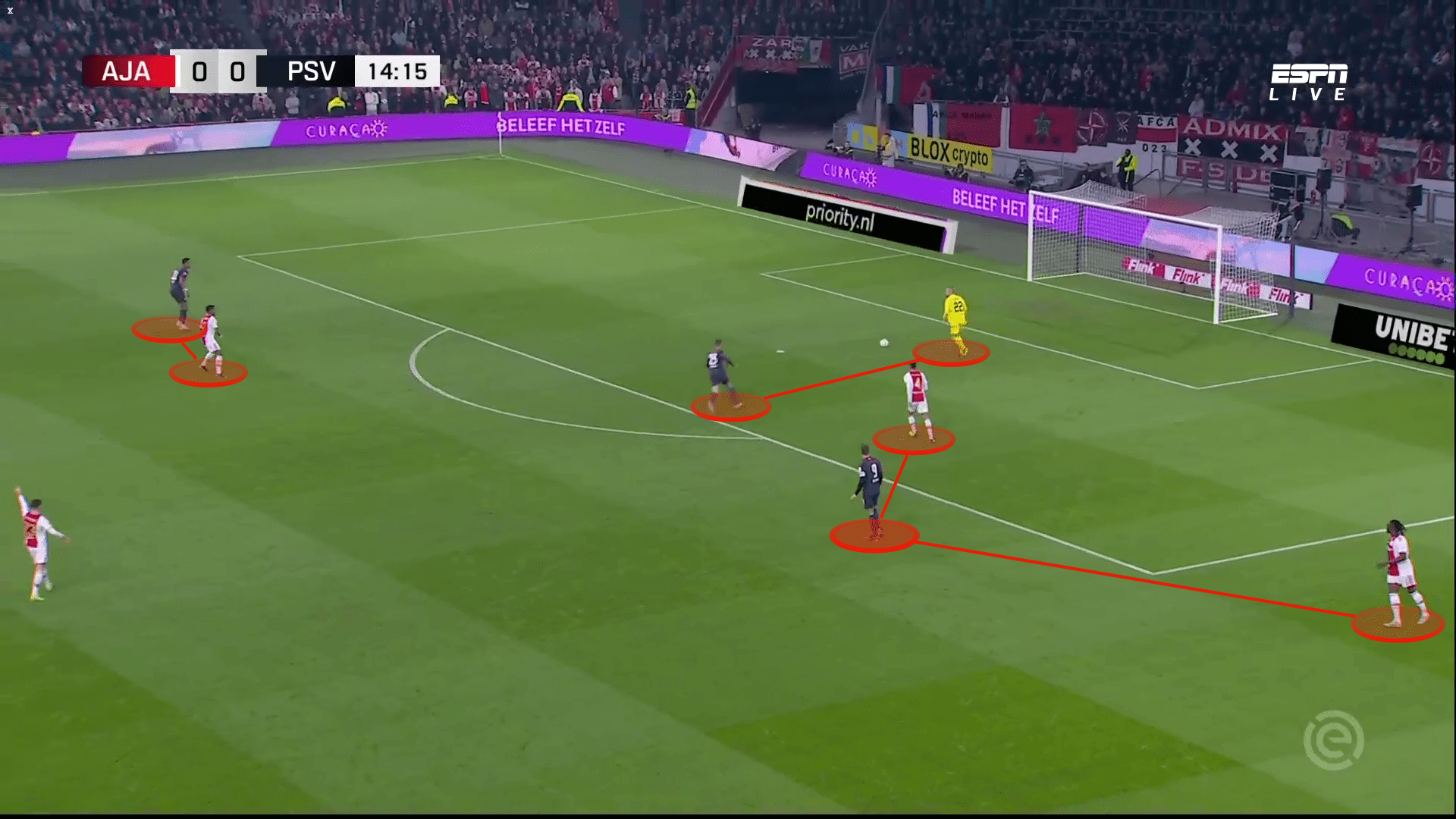
This certainly disrupts Ajax’s rhythm from creating pass combinations to moving up front.
This was one of the major reasons behind Ajax’s inability to enter the final third throughout the game.
PSV’s organisation
Throughout the defensive interaction, PSV possessed a powerful defensive organisation under Ruud van Nistelrooy’s coaching style.
Even though they were able to defend it
, they only had 36% of the game’s possessionsoverall.
PSV
took only 5 shots, just 2 of which were on target, compared to Ajax’s total of 14 shots, 5 of which wereon target.
This line summarizes the whole game.
As per Wyscout, PSV maintained its 4-2-3-1 formation for about 89% of the game, whereas Ajax stuck to its 4-1-4-1 the whole game.
To better respond to the situation, Ruud van Nistelrooy’s formation shifted the squad, which turned out to be the best course of action.
Sangaré and Veerman played a big role in the transition between formations.
It was well planned by the coach depending on the individual’s abilities which worked out fruitfully.
Veerman pairing up with de Jong to press and moving back to defend low surely helped out PSV’s defensive plan.
In one of the situations down below, Sangaré created this structure by moving to the front.
They were already positioned to defend circumstances with ease.
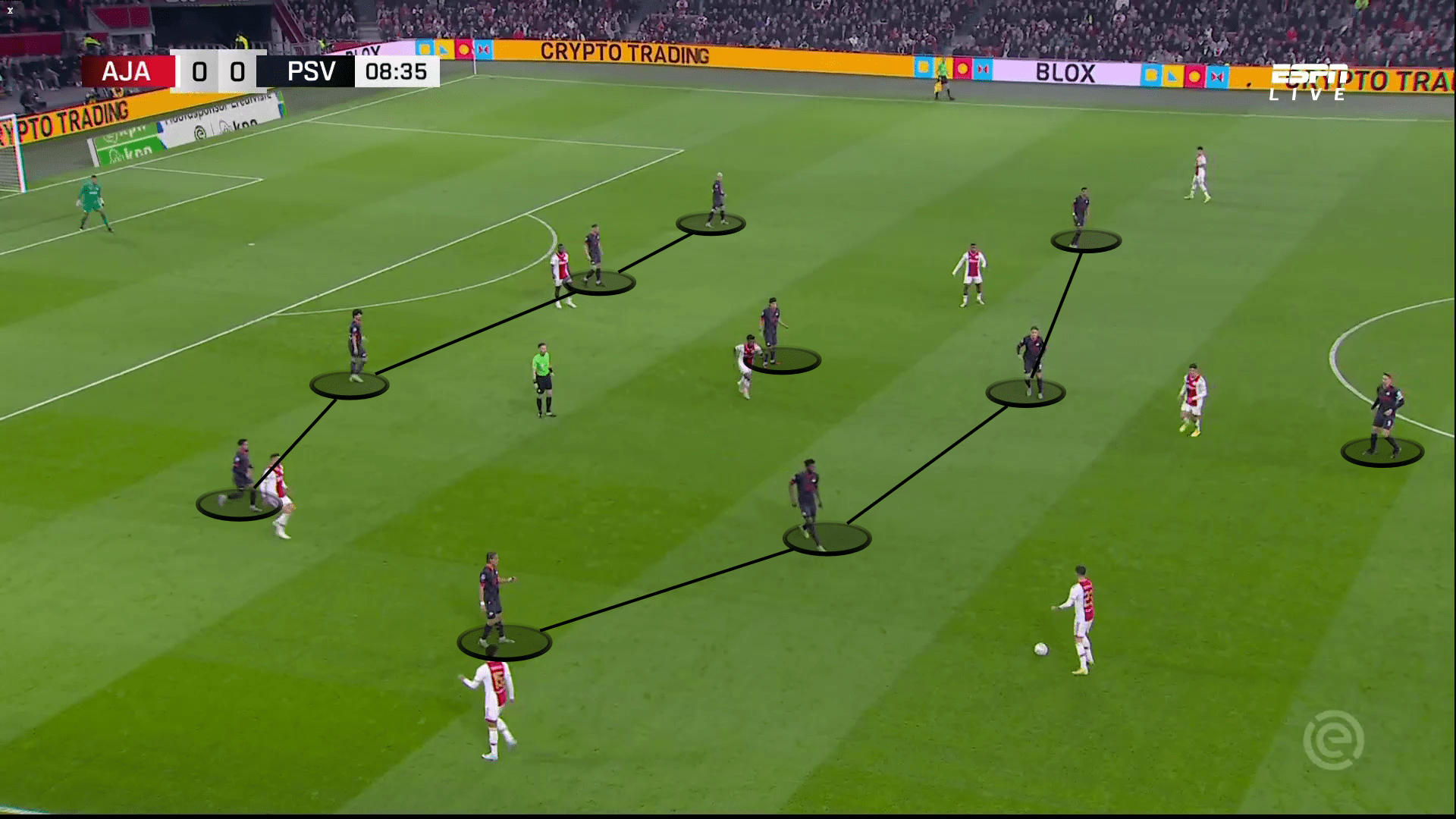
The key player for Ajax over the previous several months has been Kudus.
He has sometimes been used as a forward while acting as a false nine.
But for his purposes, Schreuder deployed him in the middle of the field.
Even though he had a fantastic game individually and often generated threats, he was not at his best since PSV made careful to stay aware of him.
An incident when Kudus was hit by an Álvarez pass but Sangaré and Gutiérrez expertly guarded each other’s backs is seen here.
The other was there to provide cover when one of them got into a fight.
The centre region was more solid than ever because of their capacity to adhere to one another tightly.
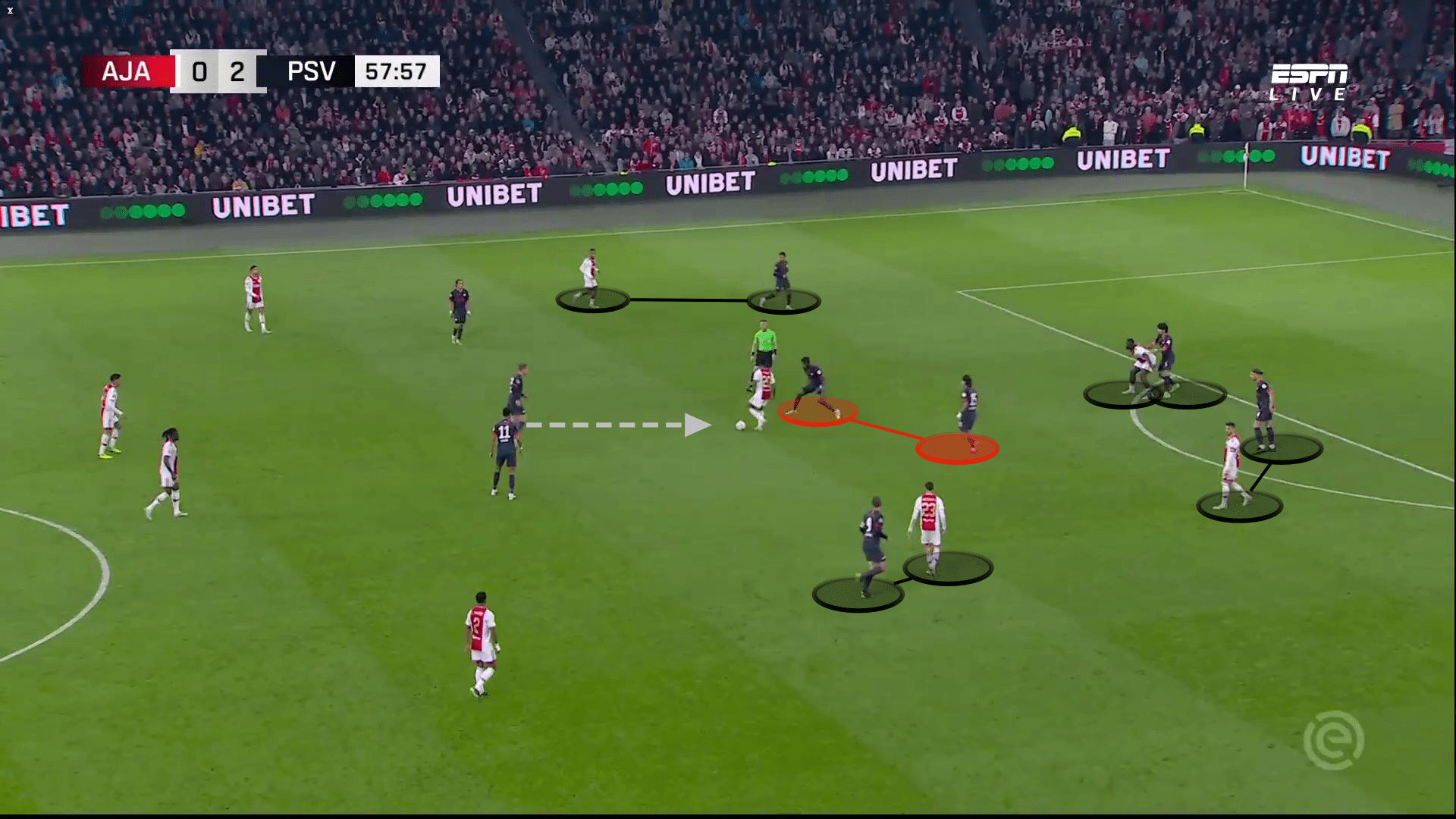
Ajax had the most of the ball possession, but PSV was able to relax and depend on counterattacks thanks to a strong low block.
PSV had 32 clearances whereas Ajax only had 12.
Even though the counterattacks during the break were brought on by one of the players’ interceptions.
Nearly twice as many interceptions were made by PSV as by Ajax, with 53.
It seems like they were ready for this.
This scenario, in which Ajax had the ball for more than three minutes while moving it left and right in search of a solution, is the ideal illustration.
Taylor found a pass to Bergwijn, but he was unable to compete with Ramalho, who had Gutiérrez covering for him and eventually lost the ball, resulting in a counterattack that almost resulted in a goal.
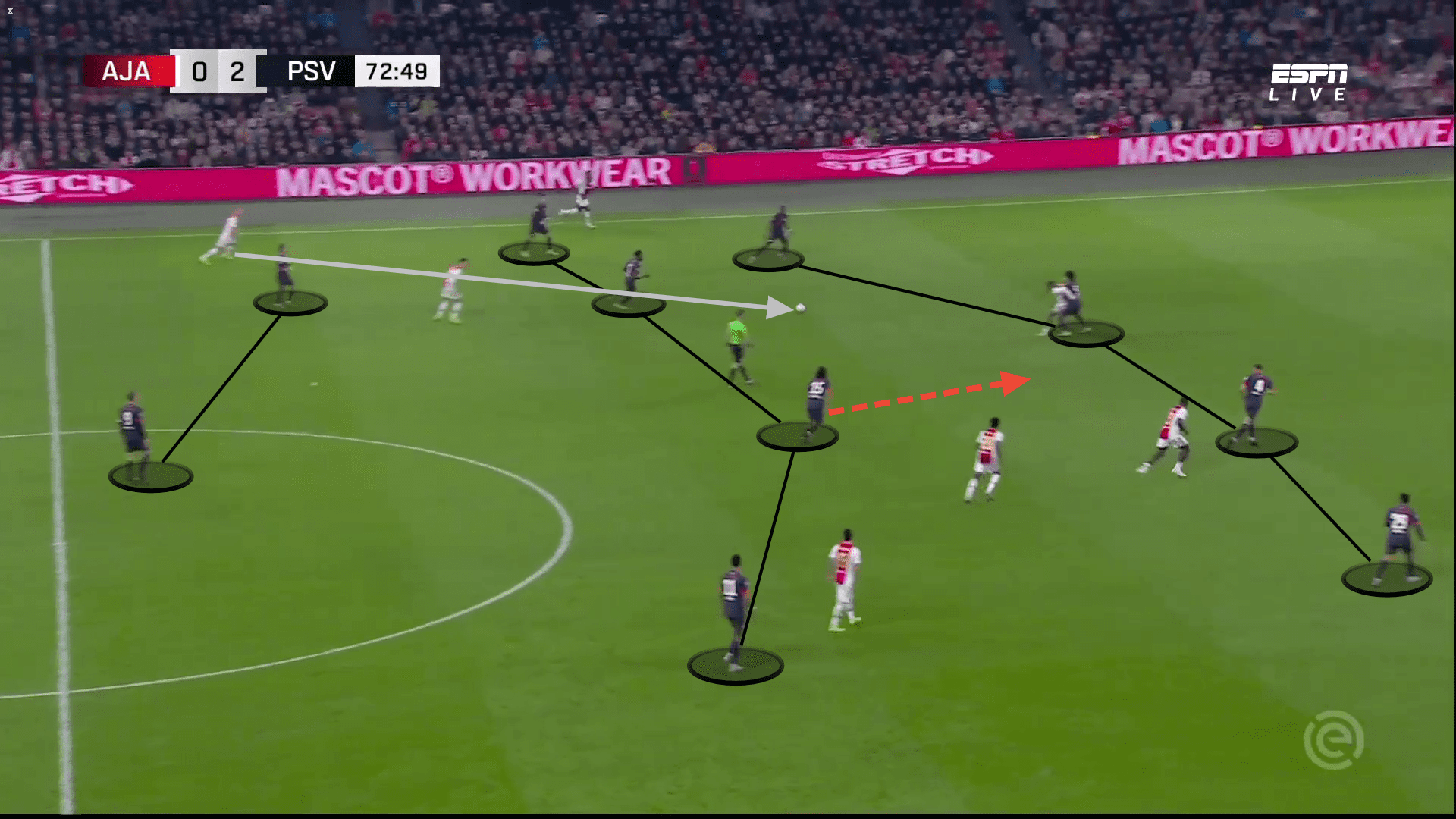
Since their counter-pressing was not at its best, PSV benefited from it.
In the picture below, Ajax sought to counter-press after losing the ball, but Sangaré swiftly saw it coming and played the ball into space before launching a counterattack.
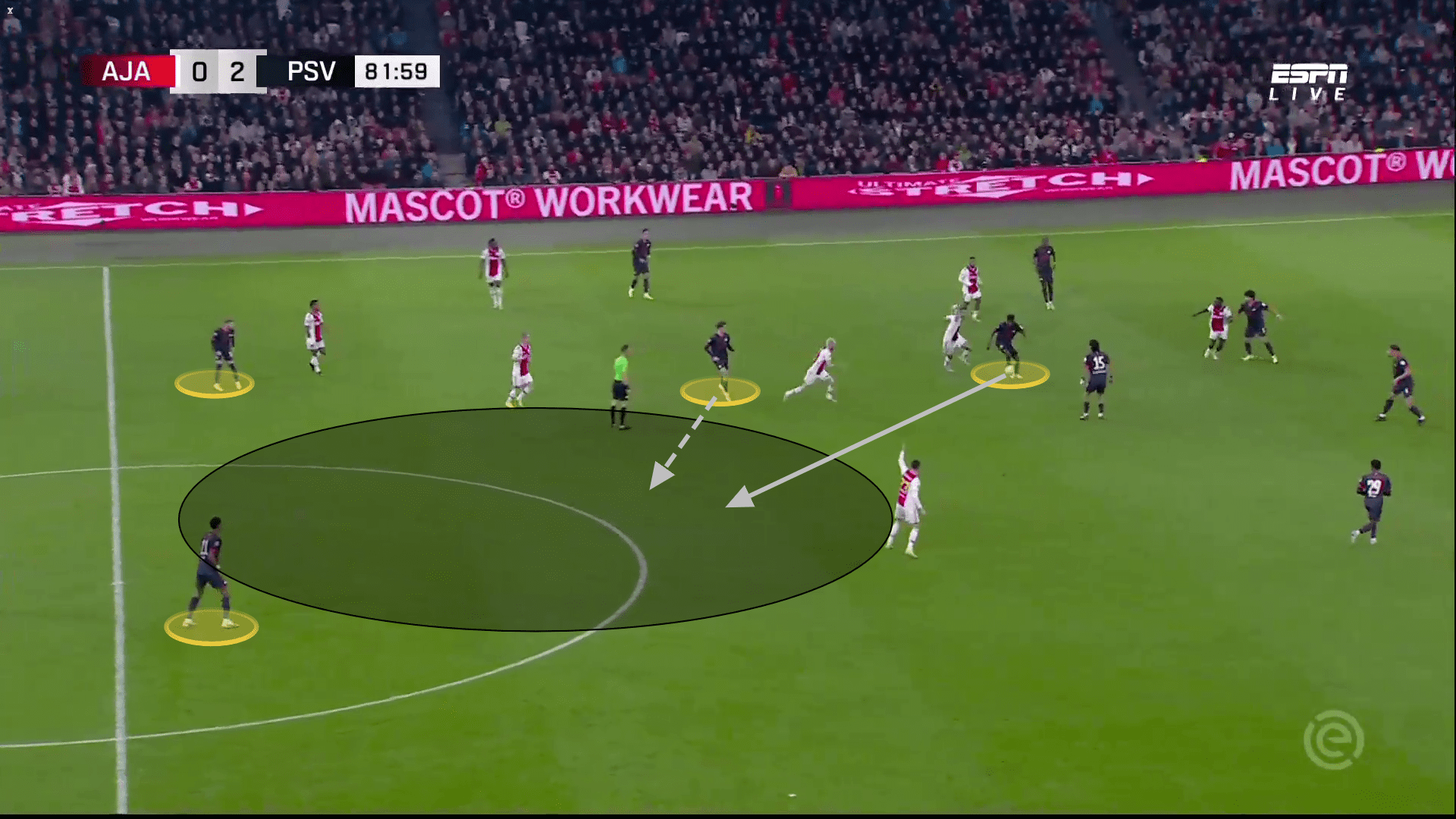
Ramalho intercepted another ball that Bassey had delivered long to Brobbey up front, putting Berguis in a position to counter-press but failing to do so.
To get past Berghuis, Sangaré and Xavi Simons partnered up with de Jong and Veerman up front, further overloading the opposition’s zone.
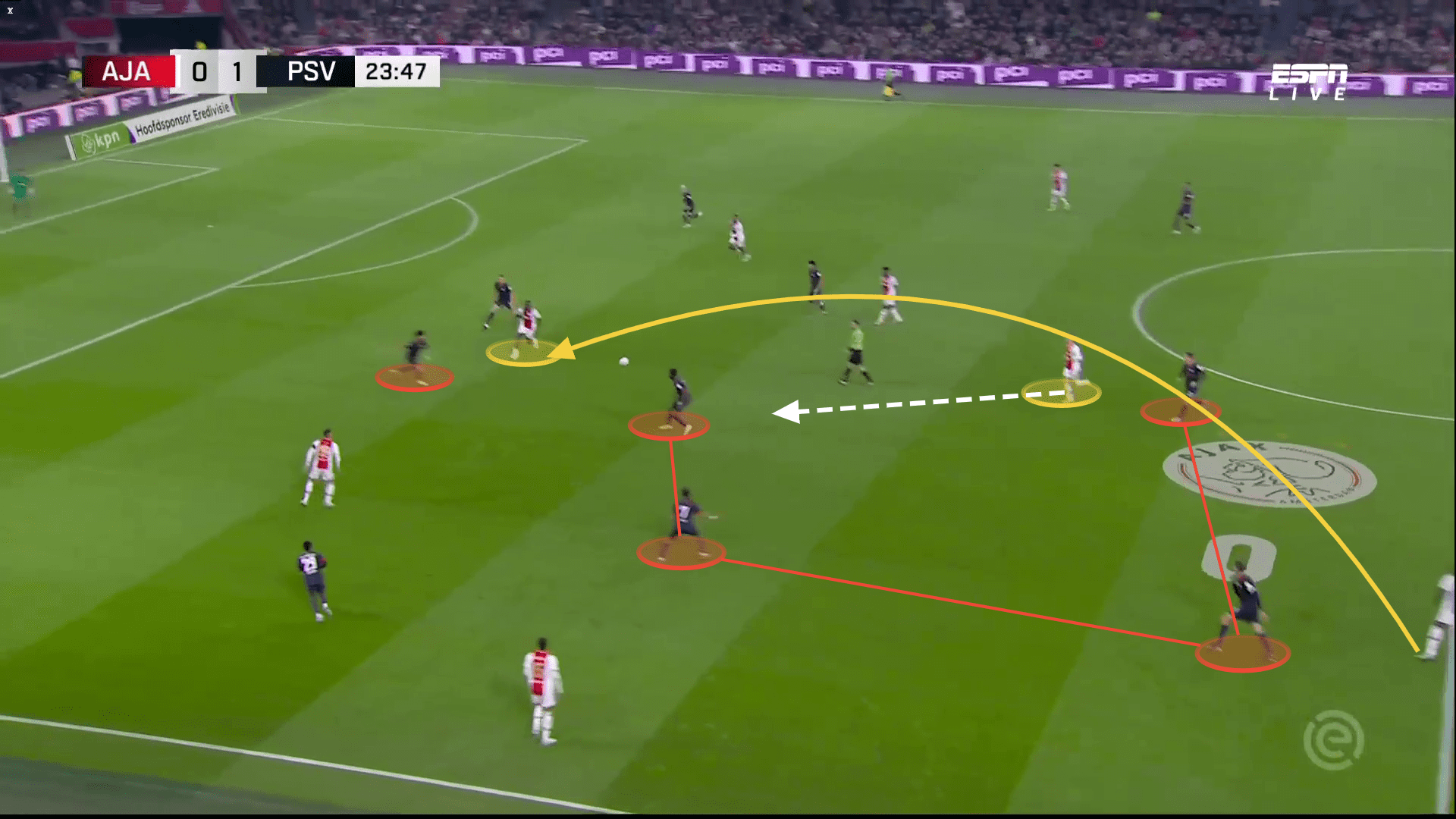
Although Ajax sometimes managed to elude the team’s press, they were content with being solid.
The moment the replacements were presented by both sides, the atmosphere on the field was electric.
Here is an illustration of how PSVs that were unable to press effectively tore apart.
Álvarez was demoted to the position of centre-back, while Bassey was moved to left-back.
Before passing to Kudus in the open space, Pasveer simply needed to find Berghuis, who moved in behind Taylor while six defenders were outmatched.
Gutiérrezs’ ignorance of Sangaré’s recovery, who is shown engaging in a battle with Berghuis, left a large gap behind.
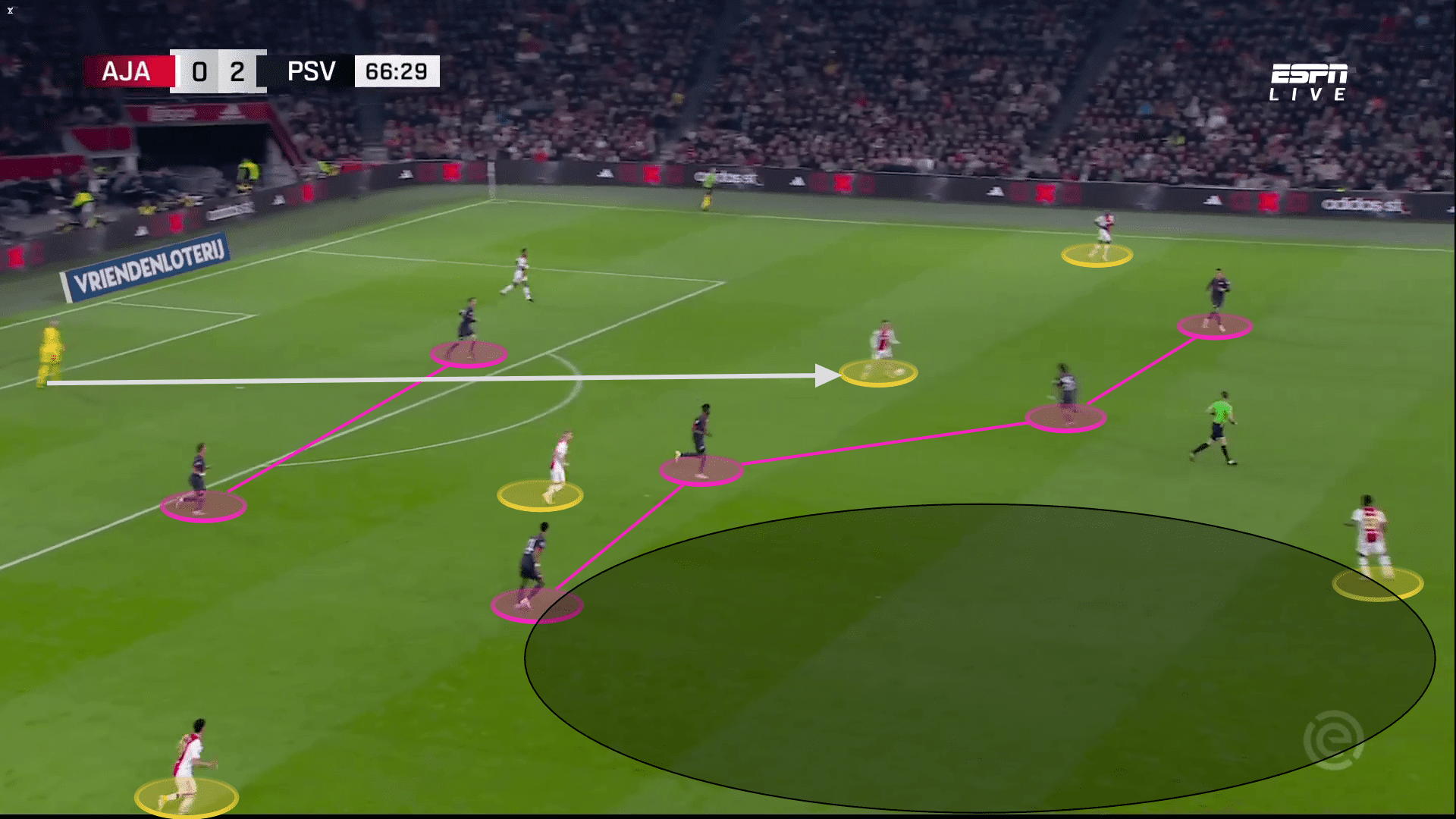
For PSV, it was Mwene who replaced Teze and Veerman for El Ghazi.
This showed the fans that the coach had it planned for his subs.
This gave a new outlook on the counterattacks where El Ghazi was a constant threat, hitting the post from a direct free kick.
Ajax was unlucky in situations, hitting the post a couple of times in the game, too.
Conclusion
PSV learned how to settle in the back by protecting each other’s back in the centre, despite Ajax dominating ball possession.
Ajax players’ individuality was all diminished as a result of this.
The counter-pressing by Alfred Schreuder was unsuccessful because Sangaré, Veerman, and Xavi were excellent with quick passes to relieve pressure, as shown in this analysis.
Ruud van Nistelrooy’s tactics were successful, preventing Ajax from securing the necessary three points to take the lead in the standings.
As many encouraging indications start to emerge, it seems exciting for PSV.
With Ajax hoping to break through this season, Schreuder is yet to find the perfect squad and rhythm to step up his game.
With two games to zero, Ruud van Nistelrooy leads Schreuder in the head-to-head battle.





Comments